NYT 9:10 (Amy)
Reagle 6:33 (Amy)
LAT 5:14 (Andy)
Hex/Hook 7:24 (pannonica)
WaPo 18:41 (Sam)
CS 18:52 (Ade)
Merl Reagle’s Sunday crossword, “Double Dating”
There’s a double “dating” theme here—the traditional long theme entries are romance-related phrases clued with reference to specific sorts of people who relate to the words used. The other “dating” theme is word fragments that can precede -dating in various words.
Here’s the first theme batch:
- 22a. [What the smitten card players often did?], HELD HANDS.
- 30a. [Like Frankenstein and the bride of Frankenstein?], MADE FOR EACH OTHER. Crafted out of spare parts.
- 48a. [What the Invisible Man thought his girlfriend was doing behind his back?], SEEING SOMEONE.
- 65a. [Like the two electricians’ dating status?], ON AGAIN, OFF AGAIN. How many electricians does it take to screw in a lightbulb?
- 86a. [All the lothario had left after his bed was repossessed?], ONE NIGHTSTAND. Great play on one-night stand!
- 101a. [What the lovestruck astronomers had?], STARS IN THEIR EYES.
- 115a. [Became the steady date of a wrestler?], GOT PINNED.
The second theme consists of [___DATING] to clue 2d: LIQUI, 4d: FLUORI, 20d: ACCOMMO, 45d: VALI, 71d: INUN, 85d: CONSOLI, 100d: INTIMI, and 109d: ELUCI. My goodness, that makes for some ugly entries. Merl’s notepad entry reads, “With an eye toward Valentine’s Day, here’s a puzzle with two themes. They have nothing in common, but they make a cute couple.” Odd approach, but it didn’t make for a challenging solve.
Least favorable crossing for those not fluent in crosswordese: 19a. [Bay window], ORIEL meets 9d. [Name in Notre Dame lore], ARA.
Other tougher bits:
- 3d. [Remove by dissolving], ELUTE. Not a super-common science word.
- 68d. [“April Love” composer Sammy], FAIN. I always want this to be CAHN or KAHN.
- 96d. [It rides the rails in Spain], TREN. If you don’t know that this cognate of “train” starts with a T and you don’t know your tawdry gossip TV shows (96a. [Celebrity gossip show], TMZ), that’s another tough crossing. And if you don’t know TMZ or 98d. [Louisiana music], ZYDECO, that Z would be hard to guess. You should know ZYDECO, though!
3.66 stars from me.
Jeremy Newton’s New York Times crossword, “Multifaceted”
Between the puzzle’s title, circled GARN, and two later circled letters in 22a, I filled in GARNET and used the theme to flush out 40a’s RUBY in CRUISE BY. The revealer phrase is split across 52d and 59d: SET IN / STONE. The seven long Across theme answers have precious or semiprecious stone names hidden in the circled letters, and their starred crossing Downs have the letters SET criss-crossing the space between the two chunks of stone name.
- 22a. [Get noticed], GARNER ATTENTION with a GARNE/T. 8d. [*Biter in Niger] is TSETSE, with the middle SET centered on the E in ATTENTION.
-
40a. [Easily defeats, in sports], CRUISES BY with RU/BY. 13d. [*One making the rounds at a party, perhaps] is CHEESE TRAY with its SET.
- 47a. [Enterprise for which a 14-year-old Buffalo Bill worked], PONY EXPRESS with ONY/X and 6d. [*Like puberty at age 16], LATE-ONSET.
- 67a. [Exploit a loophole, say], GAME THE SYSTEM, with an AMETHYST. Really nice find! I wonder if this was the germ of the theme. 50d. [*First spacecraft to orbit a comet (2014)], ROSETTA crosses it.
-
85a. [Lean back and enjoy the ride?], POP A WHEELIE. Super-lively phrase! Hides an OPA/L, crossing 81d. [*Chooses in the end], SETTLES ON.
- 96a. [Washington landmark that lent its name to a Senate committee], WATERGATE with AGATE, crossing 73d. [*Car dealership option], LEASE TO OWN, solid.
- 115a. [Big fall from the sky?], QUARTER-SIZE HAIL with QUART/Z and 99d. [*Goals for underdogs], UPSETS.
This theme concept is rather elaborate, and executed elegantly. “Word hidden in circled squares” themes can be haphazard, but this one’s tight—seven stone names split in exactly two chunks, with the crossing SETs placed in the uncircled gaps. And! Those SET-containers are a symmetrical set, and the SET IN/STONE revealer pair is also placed symmetrically. “Well, I’ll bet Newton really made a lot of compromises in the fill with all those thematic constraints on the grid.” If you ask me, the plural SWISSES cheeses is about the worst thing in the grid, and certainly I’ve seen more crosswordese and blah stuff in smaller puzzles this week. 5d: SPARSITY looks ugly, but the dictionary includes it alongside SPARSENESS. EELPOT, OMRI, ugh … but there’s also the good NERF GUN, YUMMIER, “RECKON SO,” LIP BALMS, IN A FUNK, and SHOT FOR.
Six things:
- 104a. [Big bra feature], D-CUP. I really wish some women would be in charge of the bra clues. D is really not “big,” gentlemen. The average bra size in the US is currently a DD/E, and the size range goes all the way to the middle of the alphabet, to N.
- 120a. [Wavering wail], ULULATION. If you’re like me, you learned this word when Saddam Hussein’s troops were rousted from Kuwait and women celebrated loudly.
- 48d. [Disapproving (of)], NOT A FAN. I’m okay with that as a crossword entry. I’m not a non-fan.
- 2d. [“Eureka!”], “I HAVE IT!” “I’ve got it!” sounds much more natural.
- 88a. [Jumbo-sized], OBESE. Don’t care for that clue at all. Would you call 5’6″ and 190 lb “jumbo-sized” or just heavy?
- In the electronic versions, 111a: EL AL is clued [Company with two lameds in its name], In the print version, the Hebrew letters were used … but going the wrong direction, because Hebrew is read from right to left. There’s a correction in the paper that made it to Jim Romenesko’s journalism blog. If you filled in LALE because you followed the printed Hebrew, I reckon the Times owes you a dollar.
I’m giving this puzzle 4.5 stars for the intricate gemological theme carved into sparkling facets without large flaws.
Marti DuGuay-Carpenter’s Los Angeles Times crossword, “Movie Trailers”—Andy’s review
Cute puzzle this week from Marti DuGuay-Carpenter, who’s taken some movie titles and added a word to the end, for humorous effect. The theme entries are:
- 22a, BLADE RUNNER-UP [Movie about a second-place swordsman?]. In the event that Miss Blade Runner cannot perform her duties…
- 39a, THE SHINING EXAMPLE [Movie about a case of brilliance?]. Not “A Beautiful Mind.” Or “The Theory of Everything.” Or “Good Will Hunting.” Or “The Imitation Game.”
- 56a, THE BREAKFAST CLUB SODA [Movie about a morning mixer?]. Personally, I prefer a Breakfast Seltzer.
- 80a, BACK TO THE FUTURE TENSE [Movie about remedial grammar?]. This clue will be good.
- 96a, RAGING BULL SESSION [Movie about a gabfest getting out of hand?]. What a cockamamie Kaffeeklatsch!
- 119a, GONE GIRL SCOUT [Movie about a Brownie coming of age?]. The title “Woman Scout” was rejected pretty quickly.
Only 6 theme entries in this one, but they’re pretty long and pretty good. I don’t remember a lot about this one since I solved it while I was very tired. I do remember some of the bad fill, like LEE J., RYN on top of AJA (as a constructor, I have been to the place where you have to put RYN on top of AJA, and it’s not a place I like going–at least they cross CUSHY JOB), AITS, YES I SEE?, RATA, IN A TRAP, BAR SEAT. Looking back at it now, there’s some good fill too, like ALEPPO, T-BALL, J. LO, PEACOAT, ART DECO. Mostly just unobjectionable fill, which is fine-good.
We’ll go with 3.5 stars. Until next week!
Doug Peterson’s Washington Post crossword, “The Post Puzzler No. 253”–Sam Donaldson’s review
Did anyone else think of Superman upon looking at the grid for this week’s Post Puzzler? The arrangement of black squares has me seeing a giant white S. Coincidentally, “Giant White S” was one of my childhood nicknames.
This 66/35 freestyle proved quite vexing to me. As seems to be my trend lately, I sailed through the northern hemisphere and came to a screeching halt down south. For real, three-fourths of my solving time was devoted to everything from IT’S A BOY, the [Labor day proclamation?], on down. It all started with Emily VANCAMP, the actress from TV’s “Revenge,” a series I’ve never seen. I had the V and the C but everything else took a while to emerge. I was mad the clue for MILKERS, [Octet on the eighth day of Christmas], since I knew it was in reference to “eight maids-a-milkin” but couldn’t get either MAIDS or MILKIN’ MAIDS to fit. Grr! (To be clear, my beef is with my inflexible mind and not with the clue–the clue does a nice job of making MILKERS seem lively.)
I was happy that I saw through the clue to BILLIE, [Holiday celebrated by music fans], but that was just about the only instant get in that region. I sensed that [Honeycomb home] was a reference to the cereal, so the first word of CEREAL AISLE came readily. Unfortunately, I kept wanting something like CEREAL BOX or CEREAL BOWL, and that darn URANIAN was at a pivotal crossing. Clued as [Like Titania and Oberon, astronomically], this adjective was positively Marsian in its foreignness.
Oh, and while I’ve seen T-MEN in many puzzles, I never knew it was also the name of a [1947 film noir about a counterfeiting ring]. Combine this with some basic errors (LET instead of OK’D for [Didn’t deny], PKG and LTR instead of CTN for [UPS delivery], THOM instead of THOS [Stone (signature on the Declaration of Independence)], and CUTE instead of RUDE
Oh well, there’s always next week. (How sad that we can only say that for six more weeks.)
- I’ve got a shiny nickel that says FRANKENFOOD, clued as [Genetically modified tomatoes, say], was the seed entry for this puzzle. (No pun intended there with “seed.”)
- You want some challenging clues? How about [Spades, say]? You read that and you think playing cards and shovels. So the answer is also a noun, right? Wrong. “Spades” in the clue is a verb, so DIGS UP is the answer. Then there’s [Stable charge]. That has to refer either to horses or to something related to particles, right? Nope. The answer’s just SET RATE. Curses!
- I never noticed how AL?OR??? looks an awful lot like AL GORE, which kinda-sorta fits the clue, [Concession speech deliverers]. I started to wonder whether AL GORES could be a legitimate plural for historic election losers, but luckily knew that Doug and Peter would resist forced plurals like that whenever possibile. The answer proved to be ALSO-RANS, which is terrific.
- Shout out to HOGTIE, OWIES, BAD DOG, FLU SHOT, and FROG LEGS. It’s the medium-length stuff like this that really makes the puzzle shine.
Favorite entry = CLOSE BUT NO CIGAR, clued as [“Nice try”]. Favorite clue = [Pyramid builder] for CHEERLEADER.
Emily Cox and Henry Rathvon’s CRooked crossword, “How’s Your Yiddish?” — pannonica’s write-up
Much as with baseball, there’s a long history of Yiddish in crossword puzzles. By which I mean baseball figures into a lot of crosswords, not Yiddish in baseball, though apparently a significant relationship exists there too.
This is probably because of the crossword’s origin and development in New York City, the local Jewish intellectual culture, as well as the unusual letter combinations inherent to many Yiddish words. Today’s puzzle turns the table, using Yiddish in the clues and expansive synonyms as the theme answers.
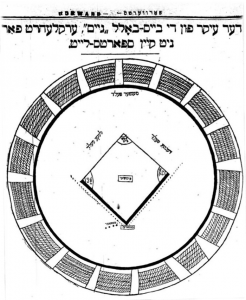 25a. [“Tchotchke”] KNICK-KNACK.
25a. [“Tchotchke”] KNICK-KNACK.- 27a. [“Schmooze”] MAKE SMALL TALK.
- 48a. [“Ganef”] SCOUNDREL.
- 50a. [“Shemozzle”] FREE-FOR-ALL.
- 61a. [“Nudnik”] PAIN IN THE NECK.
- 67a. [“Latke”] POTATO PANCAKE.
- 85a. [“Spiel”] SALES PITCH.
- 88a. [“Shamus”] DETECTIVE.
- 104a. [“Klutz”] BUTTERFINGERS.
- 111a. [“Yenta”] NOSY PARKER.
Speaking of unusual letter combinations, I’m quite taken with the stacking of IAMBS and NGAIO in the top-leftish area – hey, don’t give me tsouris under that.
- Favorite clues: 116a [Music you don’t like] NOISE; 57d [Altoid alternative] CERT (for audacity).
- Least favorite fill: 53d [City east of Wichita] IOLA. Yes, even more than row 12’s -ETH / RMS / -ERN combo.
- Speaking of 65a [Apt. parts] RMS, see also 101a [Close dorm mate] ROOMIE.
- More Yiddish: 32a [Challah, for example] BREAD; Yiddish khale, from Hebrew ḥallāh (first known use: 1907). 121a [Robot of Jewish legend] GOLEM; Yiddish goylem, from Hebrew gōlem shapeless mass (first known use: 1897). Etymology from m-w.com; usage dates refer to English.
 Very good crossword, though I solved it disturbingly quickly.
Very good crossword, though I solved it disturbingly quickly.
Martin Ashwood-Smith’s Sunday Challenge CrosSynergy crossword —Ade’s write-up
Hello there, everyone! Hope you’re having a good start to your Sunday.
Well, here’s a way to start your Sunday: a triple-stack crossword of a Sunday Challenge from Mr. Martin Ashwood-Smith. The more 15-letter entries, the more chances for me to put my skills of accurately guessing those entries with no more than one letter filled in the entry. Originally guessed “keep at arms length” to start, which wasn’t too far from what it actually was, KEEP AT A DISTANCE (1A: [Hold off]). Well, I definitely knew my initial guess was incorrect when I realized that the original guess was 16 letters in length. That wasn’t the first answer I filled in, with that honor going to another 15-letter entry, A RAISIN IN THE SUN (16A: [1959 Lorraine Hansberry play]). After that, the rest of the north was pretty much a shoo-in to fill for me, though SOX, unpredictably, took a little longer than expected (18A: [A.L. cap word]). Blanked for a little bit that the Chicago White Sox have the letters SOX on their baseball caps. YOU CAN NEVER TELL when a sports clue, which should be a cinch for me, gives me more trouble than it should (17A: [“Who knows?”]). Going to the south, one of my guesses for one of the answers was “trial and error,” but, sadly, that’s only 13 letters. Then when I got a couple of crossings, I realized that I was right, sort of, with it being BY TRIAL AND ERROR instead (53A: [One way to solve problems]). After that, the south portion of the grid went down easily as well, even when initially thinking “porterhouse steak” instead of TENDERLOIN STEAK (58A: [Pricey butcher’s cut]). There were no real hangups in the grid, though the intersection of SEHR (23D: [Very, to Wagner]) and MENEM was a tricky one (27A: [Former Argentine president Carlos]). Oh, and even though ELIHU shouldn’t refer to sports, I actually completed this puzzle on my way back from Yale University, where I was present to cover an important basketball game between Harvard and Yale (33A: [Yale of Yale]). If you want to know what happened in the game (and give my web site a hit in the process), click here. If you just want to only see the video recap/summary of the game from YouTube that I produced (which is also embedded in the story on the website) click here to do so – and make fun of my voice in the process. If you want to do neither and just read the “sports…smarter” moment, then you can do that as well!
“Sports will make you smarter” moment of the day: KAYS (1D: [Strikeout symbols, in baseball])– Henry Chadwick, 19th century sportswriter, is known as the man who invented the way of scoring baseball and box scores, and also is credited for introducing KAYS (well, Ks) as the symbol for a strikeout. Why the letter K to denote a strikeout? Because, according to stories, Chadwick used the last letter in “struck,” as the first letter, S, was already used as a symbol to denote a sacrifice. And, don’t forget, when you’re scoring a game, a strikeout swinging is denoted as a “K” and a strikeout looking is denoted by a backwards “K.”
Have a good rest of your Sunday, and thank you very much for your time!
Take care!
Ade/AOK
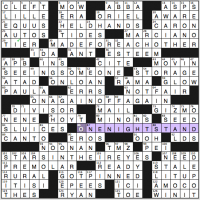
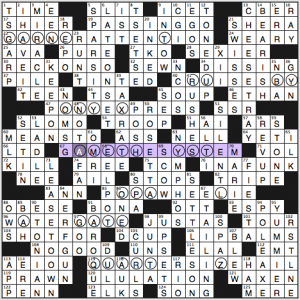
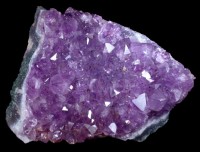
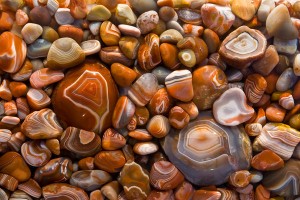
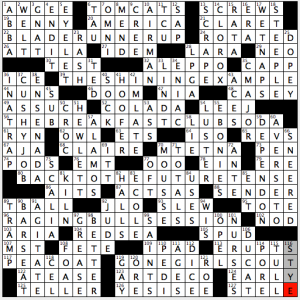
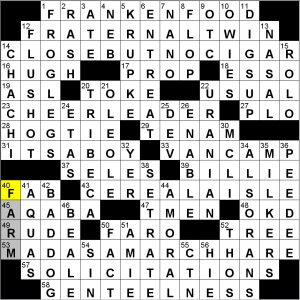

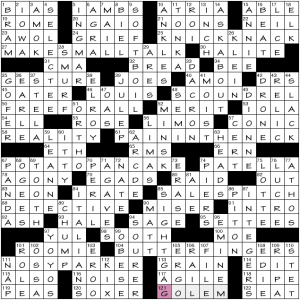

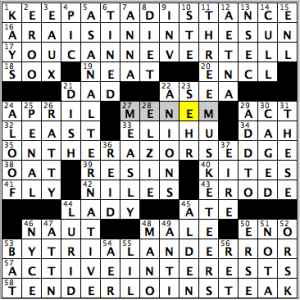
Was the first Jewish writer lefty? Why else write from right to left?
The scribe was right-handed but his medium was stone or clay, not paper.
A right-handed person holds a hammer in the right hand and chisel in the left. Control is better if you inscribe right to left because you don’t have to reach around and strike from the far side.
Sorry, good buddy, but this sounds like poppycock. References?
Here’s one.
Here’s another.
Of course, none of us were there, so I admit it’s speculative. But if it is poppycock, I’m not the poppy.
Thanks. Makes sense.
It may “make sense” but that doesn’t make it so. The sun going around the earth makes sense, to the casual observer.
Egyptian hieroglyphs and Hieratic script is also read from right to left, yet examples of this type of writing can be found painted on the walls of tombs and temples, drawn on parchment and other materials, not just engraved in stone. Is there no similar evidence of early Hebrew being scrawled, written or painted? (I’m not even going to get into the notion of using a chisel in clay. Clay is incised, not engraved.) It makes little sense that the earliest use of a language is first chiseled in stone. More likely it developed from some form of mnemonic devise or in “hard-copy” tabulation, ancient equivalence to a modern-day memo business statement. These would have been scrawled in charcoal, ink, paint or, possibly, even blood – no chisel needed.
What other ancient languages are written from right to left? What is their history of development? How did they overcome the great disadvantage of dragging the writing hand through the wet paint or ink when writing from right to left? How did they manage without being able to see what they had just written?
My guess is (and that’s all it is, a guess) that the actual, historic reason for any language being written and read from right to left makes no sense, at all.
Perhaps left-handedness was more common than right- a few thousand years ago when the Aramaic, Hebrew, and Arabic languages were developing.
There are many other languages that are read from right to left: http://en.wikipedia.org/wiki/Right-to-left
We do know that proto-cuneiform was inscribed in right-to-left columns and that around 3,000 B.C.E it switched to left-to-right. This happened around the same time that the script changed so that it could be inscribed with a stylus.
The proto-Canaanite script preceded Hebrew, Phoenician and other Canaanite languages that were all written from right to left, although proto-Canaanite, like the Egyptian hieroglyphics is was modeled on, was sometimes written from left to right. Modern transcriptions of hieroglyphics are usually left-to-right for our convenience, but when inscribed in stone right to left was the usual order.
There’s enough evidence that the order was originally chisel-friendly (and a quick hands-on experiment will confirm the difference it makes) that I consider it reasonable speculation. There’s no evidence that the ancients were left-handed. Considering how southpaws were treated by most fairly recent cultures, I doubt that they were honored by being made the scribes.
Very nice NYT. I got that all the ‘stones’ were divided by SETs, but missed the symmetry and the ‘divide in two’ details. Also got WAXED/WAXEN wrong, but TV popcult is my weakness.
I didn’t care for the NYT that much — although admittedly I didn’t notice the SETs crossing the stones. But AEIOU and RSTLNE? CBER and OMRI? UNS? BAH! SWISSES and ETAILING? (Can someone please KILL etail and all its variants? Pure crosswordese).
I continue to think SPAZ is a distasteful word, and I’m not sure about NYMPHOS either — both remind me of slang from my teenage years, best forgotten.
On the other hand, the clue for ELAL was no problem for those of us who don’t know Hebrew, except for being able to recognize what language the letters are from.
I give, what is rstlne?
The 6 letters automatically applied to the final Wheel of Fortune puzzle before the solver chooses his own.
Thanks, David—I definitely meant to mention SPAZ, which a constructor friend with a disability does find personally hurtful. Even if most Americans use it without a thought of actual spasticity, it has a mean history.
Although I am sometimes reluctant to have an instant, hair trigger reaction against every term that anyone could possibly take as offensive, I agree about the word “spaz,” and think it should be strictly excluded from crosswords. It’s a word whose only context, whose only usage, is nasty, sneering and hurtful. I’m sure the person to whom you refer is the one whom we all know, like, respect and admire. This is not the only reason for my feeling about this word, but nor is it totally irrelevant when the universe we are talking about is crosswords.
I will defend Swisses on the basis of the following from Wikepedia:
Switzerland is home to about 450 varieties of cheese.
NYT: It’s really clever to find all these familiar expressions for theme answers with embedded precious stones. And I agree, the AMETHYST in GAME THE SYSTEM is pretty amazing.
Tumbling to the theme early on was a huge help. But the first starred answer I got, ROSETTA, is a stone so I thought all the downs would somehow be related to either physical or metaphorical stones. Obviously, that was not sustainable, and I had to let go of that notion and stopped worrying about the stars to finish in good time.
I feel about this puzzle the way I feel when I enter someone’s elaborate, yet tasteful home. One extra curlicue and it would have gone over the edge. Instead, it’s been executed admirably.
Amy, you wrote about the bra clue, “…the size range goes all the way to the middle of the alphabet, to N.”
I was told, ZEBRA, is the largest size they come in.
Objecting that D is not really large seems greedy.
“Greedy”? What a strange thing to say.
The NYT was an enjoyable, quick, easy solve but, once again, I think the constructor’s construction has taken center stage, rather than looking at the puzzle from the solver’s angle. The theme was so inconsequential for me that, after seeing the encircled GARNET in 22A, I completed the puzzle without bothering to even read which gem was in the circled squares. I got the “revealer”, SET IN STONE, after I had SET IN filled in. I assumed the phrase but, like David, didn’t bother to look for or notice SET between the gems in the fill.
David and Amy also pointed out the same bumps I met while solving, to which I might add SSR, ARS, LTD, NEE, OTT, ESPY, EL AL, EMT – and that’s just from the across fill.
Who speaka da Greek? Re 2D: doesn’t “Eureka!” mean “I found it!”?
Wikipedia agrees:
http://en.wikipedia.org/wiki/Eureka_(word)
I though it meant “you smell awful” in Italian.
Of course, we all learned as tots that Archimedes spoke the exact words “Eureka, I have found it.” I take this as analogous to the Hollywood convention that “foreigners” speak English, but with the appropriate foreign accent.
There were parts of the Post Puzzler I enjoyed, but I couldn’t finish without peeking for the CHEERLEADER and CEREAL AISLE. Never heard of FRANKEN FOODS. I did like MAD AS MARCH HARE, after worrying about two Hs next to each other, and my favorite was that CLOSE BUT NO CIGAR since it harkened back to my childhood (not that anyone ever explained it)!
Eureka is the state motto of California vis a vis the Gold Rush.
Double Dating–playground retort. Shouldn’t it be “can too” not “can to”?
The version I solved had CANTO clued as 89a. [Poem part]. Perhaps that was a late correction after your newspaper received an earlier version?
Must have been an early version. The one I did had “Poem part” as the clue for CANTO.
Hi Amy,
We just finished Merl Reagle’s February 8 puzzle but we don’t understand 35 Across. Why is a pub crawler an ant? Are there lots of ants in pubs?
Thanks,
Jan
I wondered the same thing!